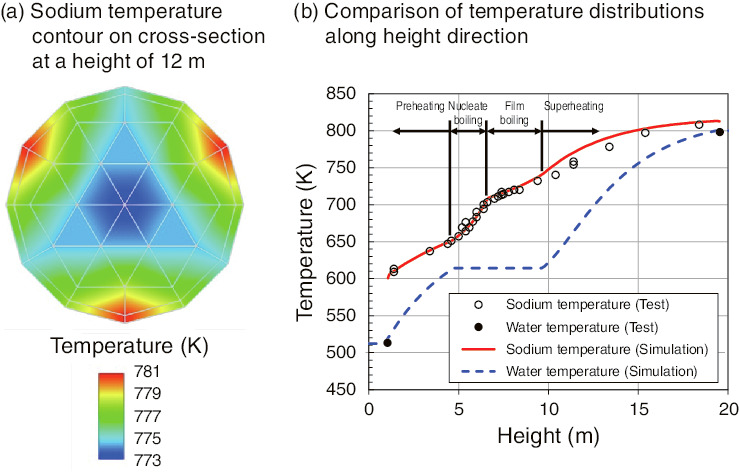
Fig.7-7 Simulation model for an SG test

Fig.7-8 Simulation results of the SG test
A double-walled straight-tube steam generator (SG) has been studied to attain high reliability and thermal capacity in sodium-cooled fast reactors. In a straight-tube SG, many heat-transfer tubes are arranged inside a cylindrical container. The water in the tubes is heated by hot sodium outside the tubes, and steam is generated. It is necessary to evaluate the temperature deviation in view of tube buckling due to thermal-expansion mismatches among tubes. The temperature deviation is caused by the nonuniform sodium flow inside the tube bundle or a lack of heat transfer near the blocked tube where flaws are detected. However, local-temperature rise could not be predicted by the previous two-dimensional simulation method with an axisymmetric assumption. For this reason, it was necessary to develop a new evaluation method capable of accurately predicting the three-dimensional temperature distribution in the SG.
In the present study, a three-dimensional thermal-hydraulic-analysis code for steam generators (TSG) was developed; this code couples the three-dimensional simulation of sodium with multi-channel-simulation of water. Specifically, a porous-body model that considered a reduction of fluid volume due to heat-transfer tubes was adopted to analyze the three-dimensional flow of sodium, and a multi-channel-simulation model was adopted to analyze steam-water two-phase flow in these heat-transfer tubes. Furthermore, a data-transfer method was developed for thermal coupling between sodium and water. To validate the TSG code, the existing SG tests were analyzed and its results were compared with the test data.
The test equipment is a 1-MWt double-walled straight-tube SG comprising 10 heat-transfer tubes, 3 dummy tubes without water in them, and 6 tie rods for maintaining the components. Fig.7-7(a) shows the simulation system and Fig.7-7(b) shows the horizontal cross-section of the simulation model. As shown in Fig.7-8(a), the sodium temperature on the outer side (where tie rods and dummy tubes exist) is higher than that at the central part (where heat-transfer tubes exist). Accordingly, the nonuniform-temperature distribution has been well captured by TSG. In Fig.7-8(b), the simulated sodium-temperature distribution along the height direction is consistent with the test data, and the influence of different heat-transfer coefficients corresponding to the flow-boiling regimes inside the heat-transfer tube (preheating, nucleate boiling, film boiling, and superheating) on the temperature distribution was confirmed. From these results, TSG was found to be applicable for analyzing three-dimensional thermal hydraulics in SG.
We plan to conduct further validation analyses and perform three-dimensional asymmetric-temperature evaluations for large-sized straight-tube SGs and structural-integrity analyses of heat-transfer tubes.